Quick links to below for Joovv vs Mito Red, RedRush vs Joovv, Mito Red vs RedRush, and Ask a Question sections.
Name
The MitoPRO 1500+ is ranked #1 best red light therapy panel for its highest grade in light output power in the main wavelengths & cost effectiveness without loss of quality or warranty.
Light Power Output
Factory Rating*
170 mW/cm2
- at 6″ distance
Tested Output
77 mW/cm2 – Tested at 6″
Comparing MitoPRO 1500+
- 10″ x 42″ Model
Wavelengths & EMFs
Red Light Wavelengths
- 630 nm
- 660 nm
- 830 nm
- 850 nm
EMF Strength*
- Negligible - 0.0 µT
Comparing MitoPRO 1500+
- 10″ x 42″ Model
Product Details
Price
• $1,169 USD
Return Policy
• 60 Day Full
Warranty
• 3 Year Full
Sizes Available
• 4 Options
Name
The RedRush 840 is by Red Therapy Co, based out of Solana Beach, CA, they are relatively new to the red light therapy scene but already receiving great feedback & reviews on their red light therapy panels.
Light Power Output
Factory Rating*
160 mW/cm2
- at 6″ distance
Tested Output
78 mW/cm2 – Tested at 6″
Comparing RedRush 840 PULSE
- 10.5″ x 38.5″ Model
Wavelengths & EMFs
Red Light Wavelengths
- 630 nm
- 660 nm
- 830 nm
- 850 nm
- *also includes "Pulsed Wave"
EMF Strength*
- Negligible - 0.0 µT
Comparing RedRush 840 PULSE
- 10.25″ x 38.5″ Model
Product Details
Price
• $1,295 USD
Return Policy
• 60 Day Full
Warranty
• 2 Year Full
Sizes Available
• 2 Options
Name
The Joovv Solo by Joovv is probably the most well known in red light therapy, currently they have the widest network of marketing in the red light therapy industry.
Light Power Output
Factory Rating*
100 mW/cm2
- at 6″ distance
Tested Output
48 mW/cm2 – Tested at 6″
Comparing Joovv Solo
- 8.75″ x 36″ Model
Wavelengths & EMFs
Red Light Wavelengths
- 630 nm
- 660 nm
- 830 nm
- 850 nm
EMF Strength*
- Negligible - 0.0 µT
Comparing Joovv Solo
- 8.75″ x 36″ Model
Product Details
Price
• $1,599 USD
Return Policy
• 60 Day Full
Warranty
• 2 Year Full
Sizes Available
• 7 Options
Note that Health Mat Review is an affiliate for some of the products linked to on this page, Mito Red Light, & Red Therapy Co. This means we receive a small commission for any purchase made with our coupons or via the links on this page at no additional charge to the customer. We use this to keep our page relevant and up to date for the community. For more information see our disclaimer at in the footer of this page.
Factory Rating * – see further information below on Irradiance Power Testing
EMF Strength* – see further information below on EMF Shielding & EMF Output of Devices
Mito Red Light vs Joovv
Mito Red Light
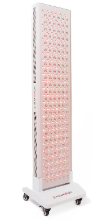
MitoPro 1500+ Size: 10″ x 42″
- 1,169 USD (MitoPro 1500+ model)
- 60 Day Full Return Policy
- 3 Year Warranty
- 630 nm Wavelength
- 660 nm Wavelength
- 830 nm Wavelength
- 850 nm Wavelength
- Larger panel size provides better body light coverage
- Higher light power output
- 4 Red Light Wavelengths vs only 2
- Lower Price but better Warranty
- No Bluetooth
- Not modular, turn on individual panels seperately
Available Sizes
MitoPRO 300+
10” x 11”
$369
MitoPRO 750+
10” x 22”
$669
Coupon Code “RLTREVIEW“
MitoPRO 1500+
10” x 42”
- $1,169
MitoPRO Mega+
17” x 64”
$2,499
Coupon Code “RLTREVIEW“
Joovv

Solo Panel Size: 8.75″ x 36″
- 1,599 USD (Solo model)
- 60 Day Full Return Policy
- 2 Year Warranty
- 660 nm Wavelength
- 850 nm Wavelength
- 630 nm Wavelength
- 830 nm Wavelength
- Bluetooth App (more EMF's, however negligible)
- Modular, connect multiple together
- Higher price for lower power
- Higher price for smaller panel, less body coverage
- Misleading light power information on the website
- Only 2 Red Light Wavelengths
Available Sizes
Solo
- 8.75″ x 36″
- $1,599
Go
- 3.75″ x 5.75″
- $599
Mini
- 8.75″ x14.75″
- $1,099
Duo
- 8.75″ x 72″
- $3,499
Max
- 17.5″ x 51″
- $5,599
Quad
- 17.5″ x 72″
- $6,899
Elite
- 26.25″ x 72″
- $10,499
Mito Red Light vs Joovv - What to Consider
When looking for a red light therapy panel or device, there is a lot of marketing and information available on all brands which can make it difficult to pick out which panel or device will be the best for you.
Putting the different factors into context can make your choices easier to make, and when considering red light therapy, thankfully there really aren’t that many factors to be considered.
Primarily we want to make sure that the product we choose is going to provide the most effective red light therapy, thankfully this is easy to determine based on the research available on the topic.
There are 2 highly effective wavelengths of red light therapy light, 660nm and 850nm, this is the first box to check when considering any device; and most devices check this off.
The second factor in effectiveness is going to be the power of the light, this can be measured in more than one way but it’s important to be aware that these measurements could be construed to mislead.
This is one thing which we don’t like about the Joovv devices, despite otherwise appearing to be good products.
If you visit the Joovv website you’ll see that they compare the Joovv Elite and Joov Solo devices against a “Device A” and a “Device B”.
At first glance it appears that the Joovv devices deliver far greater light power output in Total Light Output (watts), Energy per area (cm2) in 10 minutes (joules) and in Total Energy Output in 10 Minutes (joules).
Why did they pick Device A and Device B to be half the size or even smaller than the Joovv Solo when the competition’s products are actually relatively the same size, for example the MitoMax 9″ x 36″ and Joovv Solo 8.5″ x 36″?
Perhaps this is because if they compare total output power per surface area at 6″ distance, despite the Joovv being a lower powered device, it will show the Joovv with higher output per panel surface area.
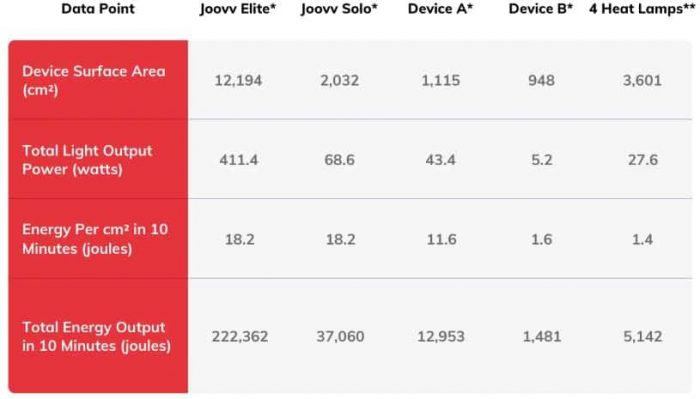
Of course it is clear to see that Device A, half the size, will output less Total Light Output, and less Total Energy Output in 10 minutes, but the Energy Per Area (cm2) looks like it is heavily lacking for the smaller devices.
When we look at the light energy output per panel area shouldn’t it be the same or close to the Joovv because we’ve accounted for the size?
This is in fact not the case, because for a larger light panel you will have far more light rays converging on your point of measurement 6″ away.
If you want to measure the relative light power output of different sized panels, then an accurate comparison would be Total Light Output per Device Surface Area, calculated as follows:
Device A = 43.4 watts / 1,115 cm2 = 38.9 milliwatts
Joovv Solo = 68.6 watts / 2,032cm2 = 33.7 milliwatts
Very apparent that the output power of the Joovv is in fact less per panel size area than Device A.
But wait the data shows that Energy Per cm2 in 10 Minutes (joules) is greater for the Joovv Solo than Device A.
This is because this measurement was taken at 6″ distance from the panels.
To put this in perspective, if we took a Joovv Solo, and made it the same size as Device A, what will we see for Energy per cm2 in 10 Minutes (joules)?
We can extrapolate a ratio from the numbers we calculated above, 38.9 milliwatts / 33.7 milliwatts = 1.154, this shows that Device A without considering size, outputs 15.4% more than the Solo, reducing the measured Energy per cm2 in 10 Minutes (joules) of Device A by the same ratio we can find an estimated output for a Joovv Solo of the same size.
Joovv Solo of same size as Device A = 11.6 Joules / 1.154 = 10 Joules of Energy per cm2 in 10 Minutes vs 11.6 Joules from Device A.
This is simply important to be aware of so that we can make informative decisions based on information from a level playing field.
A better comparison would be for instance the measurement data from the Mito Red Light MitoMax device, which is the same size as the Joovv Solo.
Note that: the MitoMax devices are the previous flagship devices from Mito Red Light, still available depending upon availability, but for a larger panel, additional red light therapy wavelengths with a price still better than the competition we now are recommending the MitoPRO 1500+ panel.
Thankfully both brands provide this measurement data for us to compare as we’ve excerpted below for you,
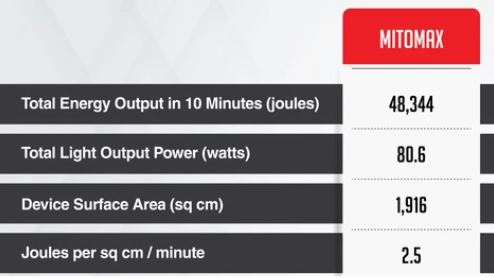
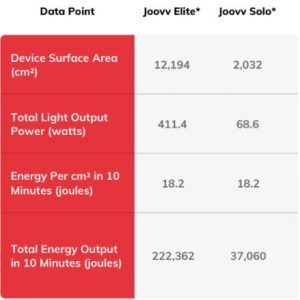
With the figures above it’s much easier to see an accurate representation of power data between devices of similar panel sizing.
The important ones to consider are the Total Light Power, 80.6 watts vs 68.6 watts and Total Energy Output in 10 minutes, 48,344 Joules vs 37,060 Joules.
With these factors considered, the Joovv is still a high quality red light therapy device, and provides the option to combine your panels into modules to turn on at the same time and control via Bluetooth whereas you would need to control your Mito Red Light like you would any other light in your house and if using multiple Mito Red Lights together would need to turn them on individually.
For us the modular and Bluetooth abilities of the Joovv aren’t high on the priority list because we’re looking primarily for the most effective product per dollar spent, and therefore our top choice in this case is the Mito Red Light.
We hope you’ve found this article helpful in your research and if you have please share it with your friends!
Joovv vs RedRush Red Therapy Co
Joovv

Solo Panel Size: 8.5″ x 36″
- 1,599 USD (Solo model)
- 60 Day Full Return Policy
- 2 Year Warranty
- 660 nm Wavelength
- 850 nm Wavelength
- 100 mw/cm2 Light Power
- Bluetooth App (more EMF's, however negligible)
- Modular, connect multiple together
- Higher price for lower power
- Misleading light power information on their website
Available Sizes
Solo
- 8.75″ x 36″
- $1,599
Go
- 3.75″ x 5.75″
- $599
Mini
- 8.75″ x14.75″
- $1,099
Duo
- 8.75″ x 72″
- $3,499
Max
- 17.5″ x 51″
- $5,599
Quad
- 17.5″ x 72″
- $6,899
Elite
- 26.25″ x 72″
- $10,499
RedRush Red Therapy Co

RedRush 840 Panel Size: 10.25″ x 38.5″
- 1,295 USD (RedRush 840 model)
- 60 Day Full Return Policy
- 2 Year Warranty
- 660 nm Wavelength
- 850 nm Wavelength
- Pulsed Wave
- 100.5 mw/cm2 Light Power
- Bluetooth App (more EMF's, however negligible)
- Much lower price but same or better warranty & other factors
- Higher Light Power Output
- Includes "Pulsed Wave"
- Not modular, turn on individual panels seperately
Available Sizes
RedRush 840 Pulse
10.25” x 38.5”
$1,295
Coupon Code “HMRRED“
RedRush 400 Pulse
9.2” x 23”
- $745
Coupon Code “HMRRED“
Joovv vs RedRush Red Therapy Co - What to Consider
As with any large purchase, it’s important to identify what is important to you in a red light therapy device and then make your choice accordingly.
Both the Joovv and the RedRush (and MitoRed), all have excellent 60 day guarantee return policies, along with 2 year warranty policies (except MitoRed with 3 year warranty) and 50,000 hour rated lights including both effective wavelengths, 660nm and 850nm.
With these purchase factors all equivalent the differences boil down to, light power, accessories, and size choice.
When regarding the light power discussion between the Joovv and the RedRush devices there is some gray area.
The Joovv provides more light power information on their website than the RedRush does including some testing, however the RedRush provides irradiance power figures at different distances from their device.
The Joovv lists their irradiance as 100 mw/cm2, and adds an asterisk to say at the bottom “* Irradiance varies based on wavelength configuration and distance from the device.”
The RedRush lists their irradiance as 160 mw/cm2 at 6”.
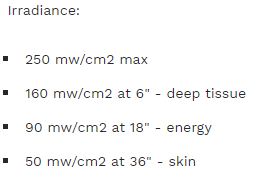


We wonder why would the Joovv not simply state at which distance away from their device this 100 mw/cm2 measurement or factory rating was made.
We can only assume that it is made at 6” from their device as indicated by their other power data tables and being a standard testing distance.
In the interest of potential customers we hope that Joovv will update their power information to be easier to understand without trying to read between the lines as currently it does make one speculate whether this information has been left out for a reason (because their device is underpowered relative to the competition?).
Interestingly enough, since first posting this review page, the RedRush has been updated from the 720 model to the 840 Pulse model, and while being the same size as the older panel, the irradiance power has increased dramatically.
Here below you can see the excerpt (which we saved from the first version of this review page) from RedRush’s website about the power of the older, discontinued 720 device, with only 100.5 mw/cm2 irradiance, versus the current 840 device at 160 mw/cm2 at 6″ that we saw in the table above.
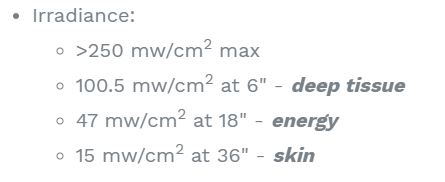
The difference between the old 720 device and new 840 with irradiance power output shows that RedRush has significantly upgraded their device.
It is curious then, that the Joovv Solo is still only at 100 mw/cm2, it hasn’t been upgraded since we first posted this review page, almost seeming now like an outdated product.
Regarding accessories between the devices, both the RedRush and the Joovv both come with an app you can download for free to monitor your red light therapy session length to optimize the session.
The RedRush also comes with a pair of light reducing glasses to wear with your session which the Joovv does not include, otherwise accessories include mounting screws and cables and are more or less the same.
Joovv certainly has a leg up on the RedRush in terms of different sized devices available with 7 different sizes compared to the RedRush having only 2 available.
The Solo is the most popular product by Joovv, as it is a healthy medium between an ultra large and expensive panel, and a smaller panel which can’t cover the same treatment area.
The RedRush 840 is effectively the same size as the Joovv Solo, so despite having only 2 options available, RedRush does offer the popular size of device for a good balance between treatment area provided for the cost.
With the warranty, guarantee, and other standard factors all equal for personal home use we don’t feel the need to spend multiple thousands of dollars to build a large modular set up like is offered with Joovv and therefore would rather take the slightly more powerful RedRush 840 device for a steep discount compared to the equivalent Joovv.
We hope this article has been helpful to you in making a red light therapy choice for yourself and if it has please share it with your friends!
RedRush vs Mito Red Light
Red Therapy Co RedRush

RedRush 840 Panel Size: 10.25″ x 38.5″
- 1,295 USD (RedRush 840 model)
- 60 Day Full Return Policy
- 2 Year Warranty
- 660 nm Wavelength
- 850 nm Wavelength
- Pulsed Wave
- 630 nm Wavelength
- 830 nm Wavelength
- Bluetooth App (more EMF's, however negligible)
- Similar light power output
- Includes "Pulsed Wave"
- Not modular, turn on individual panels seperately
- Less Sizes Available
Available Sizes
RedRush 840 Pulse
10.25” x 38.5”
$1,295
Coupon Code “HMRRED“
RedRush 400 Pulse
9.2” x 23”
- $745
Coupon Code “HMRRED“
Mito Red Light

MitoPro 1500+ Size: 10″ x 42″
- 1,169 USD (MitoPro 1500+ model)
- 60 Day Full Return Policy
- 3 Year Warranty
- 630 nm Wavelength
- 660 nm Wavelength
- 830 nm Wavelength
- 850 nm Wavelength
- Larger panel size provides better body light coverage
- 4 Red Light Wavelengths vs only 2
- Lower Price but better Warranty
- Similar light power output, but no Pulsed Wave
- No Bluetooth
- Not modular, turn on individual panels seperately
Available Sizes
MitoPRO 300+
10” x 11”
$369
MitoPRO 750+
10” x 22”
$669
Coupon Code “RLTREVIEW“
MitoPRO 1500+
10” x 42”
- $1,169
MitoPRO Mega+
17” x 64”
$2,499
Coupon Code “RLTREVIEW“
RedRush vs Mito Red Light - What to Consider
Here we compare our top two ranked red light therapy devices, the RedRush and the Mito Red Light.
These two are much more similar to one another than they are to any of the Joovv devices.
They both include the commonly known most effective light wavelengths of 660nm and 850nm, but with Mito’s newer devices, the PRO series, you also get an additional 2 wavelengths of red light therapy the 630nm and 830nm ranges.
Previously both RedRush and Mito Red Light had comparable warranties as well, but in recent times Mito Red Light has upgraded their warranty period to be 3 years when compared to RedRush’s 2 year warranty which has remained.
Both the RedRush and the Mito Red have much greater light power than the Joovv devices, and against one another are stack up pretty well as comparable in terms of light power, but in terms of panel size, Mito has a few extra inches on the RedRush, which will give you a larger red light therapy coverage area which is an advantage.
At this point, neither of these devices are very comparable to what you get with a Joovv device.
The RedRush products all come with a free app to help you manage your red light therapy sessions to get the most out of each session.
Personally this author likely wouldn’t use an app even if it was free to help guide red light therapy sessions because you really only need to be conscious of how close you are to the light and how much time you spend in front of it.
However we can’t speak for you, and it would certainly be fun to use an app to keep on track and get the most out of your red light therapy device.
Just like when we compared the RedRush to the Joovv, the RedRush certainly has less size options than the MitoRed.
This lack of alternative sizing is not a deal breaker for us as the most popular size and the size which we would order is still available from RedRush.
It may be worth noting that because of the higher light power of these devices they do likely emit negligible levels of EMF’s (as does Bluetooth), but once you move to a red light therapy application distance of a few inches these EMF’s likely drop to being undetectable. I wrote a bit more on the topic of EMF’s a little further down the page.
Also worth noting is that the RedRush includes something they call Pulsed Wave, which they don’t explain very much on their website, but I think they are referring to PEMF, pulsed electromagnetic field therapy, which has been shown to benefit a wide range of issues and aid in recovery. I’ve written extensively on the topic of PEMF therapy on this website so if you’re interested check out our page on the topic.
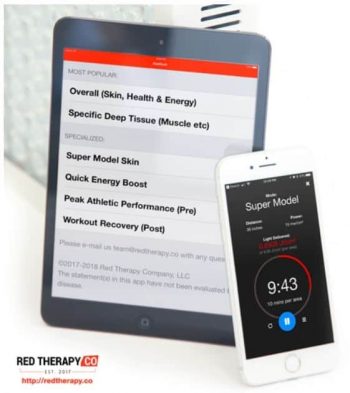
All in all, between these 2 devices one really cannot go wrong.
Final thoughts would be simply that if you’re keen to use an app to keep you on track with your red light therapy, go for the RedRush, and if you’re indifferent to using the app and would prefer a couple extra red light wavelengths and a little wider application light coverage (and want the peace of mind of an extra year on your warranty) go for the Mito Red Light MitoPRO 1500+.
We hope all these comparisons and collected product data & policies have been useful to you, don’t forget to share our page with others if you’ve found it helpful!
Irradiance Power Testing
The different brands all state irradiance power of their devices at 6” in mW/cm2, this is as summarized in the table at the top of the page.
Some of them also provide irradiance power of the devices at varying distances, however 6” is the standard and also is provided for all three devices which makes for an easy comparison.
Joovv and Mito Red Light also provide total light output energy in Joules via an independent testing organization, at least for some of their original flagship devices (like the MitoMax).
The range of total output energy in Joules we’ve provided above for the RedRush is based on the mW/cm2 at 6” to the tested output in Joules ratio for the Joovv and the Mito Red Light. Using these ratios we extrapolate the value of Joules output in 10 minutes for the Red Rush to give ourselves a picture of its likely range of output in Joules.
Typically when we go to measure what factory reported power levels are for any kind of device the measurements we find are lower than what the factory reports, a common example of this is the rated horsepower of a car versus what an independent test would find.
This is because like in our car horsepower example, the factory tests the power at the motor, before it even gets put into a car.
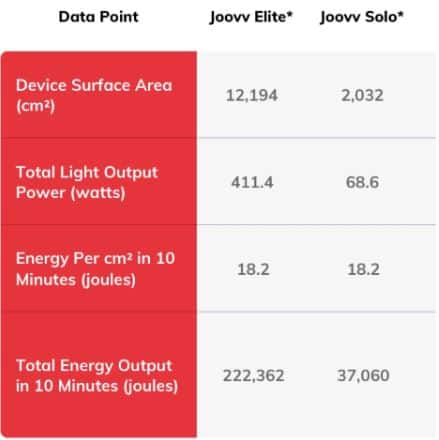

Similarly when we test power output of red light therapy devices, we will likely see a lower power level when testing in a real life application.
Above we report independent testing values for the power output which we found and they appear to correspond with the factory reported irradiance power.
Remember that with distance from the device’s red light output that this irradiance energy drops off quickly.
While some argue that it’s very important to be further away such that you don’t have “hot spots”, the spots where the light is shining on brighter, we argue that by simply moving or shifting position a little during treatment solves this issue.
EMF Shielding & EMF Output of Devices
In the above table we report the EMF’s of all devices to be in the negligible range.
This means that you can safely set aside your worries of EMFs from all of these products when comparing them to make a choice.
We say that they are all negligible for a couple of reasons.
First, they are all in the range of less than 0.0 microTesla.
We searched the PubMed website for articles testing the damages from different strength intensities of EMFs to find out what levels should have us worried.
We found one article, A Review on Electromagnetic Fields EMFs, which found in the range of milliTesla we should be careful with lengthy exposures; 1 milliTesla is equal to 1000 microTesla.
All of the red therapy devices are in the range of 0.0 microTesla, this would mean that they would need to emit EMFs more than 10,000 times stronger to reach levels where caution should be exercised.
Additionally this study found that even lengthy exposures at the 500 microTesla range showed no adverse affects, and even then to reach those levels these red light devices would need to emit EMFs more than 5,000 times greater than they are now.
Second reason that we say they are negligible is in a comparison to everyday electronic devices.
This helpful website lists the EMFs from everyday electronics including laptops and iPhones, EMF Levels of Apple Devices.
What we find is that they are all also operating in this same range as the red light therapy devices.
You can see this for yourself by taking the mV/m EMF figures they provide on the website and converting them in to microTesla, a helpful tool for this is this webpage, Field Strength Calculator.
Read more about how to protect yourself from EMF’s and restore damage from them on our page EMF Protection.
Red Light Therapy Mats
Something I thought worth mentioning that some people may not have known were an option are red light therapy mats.
This review page has compared 3 of the most popular red light therapy panels, but for some, being able to lay down, or even wrap parts of your body for red light therapy treatment may be a more desirable option.
Really for myself when it comes to these type of therapy devices, often times the ease of use really plays a factor into how often you actually use your therapy device.
For some, getting their red light therapy while on the couch with their red light therapy mat wrapped around or under them may be a better option.
I’ll leave an example of 2 different red light therapy mats here just to give a little perspective of what may be available out there.
One is also from our top recommended red light brand, Mito Red Light, and the other is actually primarily a infrared heat, negative ion and PEMF therapy mat, which additionally includes red light therapy.
Mito Red Light Therapy Mat - Full Body
- 660nm Red Light Therapy
- 810nm Red Light Therapy
- 830nm Red Light Therapy
Return Policy
• 60 Day Full
Warranty
• 1 Year
Price
• $999 USD
The Mito Red Light therapy mat includes 3 red light therapy wavelengths, and 2 of them, the 810 and 830nm ranges are in the near infrared wavelength.
The near infrared is more focused toward muscle and joint pain, blood circulation and so forth than it is more skin rejuvenation focused like the 630 and 660nm ranges of red light.
This is actually somewhat similar to the Healthy Wave infrared mats as their infrared heat is more focused towards circulation, and muscle and joint pain relief like the higher 800 range red light wavelengths are.
The Mito Red Light mat is 62″ x 24″ so it makes a good size for yoga or stretching practice.
The Healthy Wave Mat we show here is a smaller version but also comes in larger options like the Mito mat.
Healthy Wave Infrared, PEMF, Red Light Mat
- 660nm Red Light Therapy
- PEMF Therapy
- Infrared Therapy
- Negative Ion Therapy
Return Policy
• 90 Day Full
Warranty
• 15 Month Full (controller 5 year)
Price
• $349 USD
You can learn more about the benefits of infrared and PEMF on our pages on Infrared Mat Benefits and the PEMF Mat Benefits.
You’ll find if you read those pages that interestingly many of the benefits of these 2 therapies run parallel to red light therapy and can be great to use in combination with one another.
Important to note is that the red light therapy of the Healthy Wave mat isn’t nearly as strong as the Mito mat simply because of the number of LEDs in the mat.
It seemed pertinent to mention these two mats in this red light therapy review for the people looking for red light therapy as a pain management and muscle recovery tool because the Mito red light therapy mat that focuses on the 810nm and 830nm light wavelengths which targets this, as does the Healthy Wave mat’s infrared and PEMF therapy.
If you made it this far down the page, then thank you for reading!
It took a lot of time and thought to put this page together so I really do hope its helped you, if it did, please share it with friends or family who would be interested.



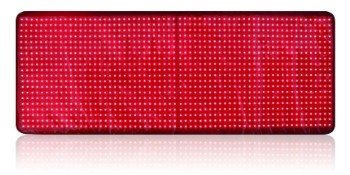
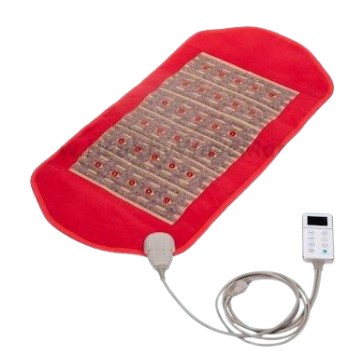

Thanks for this thorough list.
Happy to help!
I’m looking primarily for a way to strengthen vision. I’ve read in studies, all agree that the wave length is 670nm, but that the intensity of light when lower. This is a brief excerpt from one study: “For this study the light energy emitted by the LED torch was just 8mW/cm2, rather than 40mW/cm2, which they had previously used. This has the effect of dimming the light but does not affect the wavelength. While both energy levels are perfectly safe for the human eye, reducing the energy further is an additional benefit.” Many red light devices that I’ve seen on line, are used for skin and actually show models with eye shields. Same wave length but significantly higher intensity. Is it necessary to have 2 different devices one for skin, muscle, inflammation, injury, etc an another for eye therapy? Any clarification would sure be appreciated. thanks. S
Hi Sue,
I would say the only reason to have different devices is for their ease of application.
A red light panel or red light therapy mat is probably easiest for full body application, whereas a red light therapy mask might be easier for applying to the face.
If it’s for skin, muscle, inflammation, I wouldn’t be too concerned with going at a too high red light intensity.
What you could do, if you’re concerned about the intensity of the red light for the eyes, is move further and further away from the device until it feels comfortable for the eyes, as the light intensity will drop over distance.
Sorry I don’t have a direct answer as to what would be eye safe when it comes to red light therapy… I would recommend talking to your optometrist to get their opinion based on your own eyes.
Hope this helped just a little 🙂
Greg
Can you do a comparison to the UltraSlim? They are charging $150,000 to practitioners and claiming a guaranteed 2″ of fat loss per 30 minute session.
There is also Hooga, Nuwave & ContourLight to consider. Please let me know if you have time to do that comparison?
Hi Keith,
thanks for the comment.
I’m working on a big project for our website right now, so it will be some time before I can investigate this further, but thank you for bringing these devices up.
I’ll certainly be interested to look in to them further in the future, and when I do, I’ll comment back here so that you get a notification.
Sorry I don’t have an answer for you today!
Thanks again
I would very much like to see those reviews and comparisons too!
Hi Joann,
thanks for the comment.
Looks like the review requests are stacking up, I’m working as fast as I can!
Hopefully will have more for you all soon!
Do any of the red lite devices treat numbness in the legs & feet & if they do which one would you suggest i buy . thank you
Hi Billy,
thanks for the comment.
This is something I don’t know the answer to, whether it treats numbness in legs and feet. I would suggest trying to search the Pubmed website to see if there are any studies regarding red light therapy and helping with numbness, I suspect it would depend on the cause of the numbness as well.
If you find enough compelling information to suggest that red light therapy would help in your case, then I still recommend the MitoPRO red light device, however any of the ones on this page would do the job as they all utilize the two main red light wavelengths.
Sorry I couldn’t help more.
Thanks,
Greg
Is there an update on this?
Hi Erin,
thanks for the comment, I had to wait until I managed to do a full update to this page to reply, but now I can say yes, this red light therapy review page is all up to date now.
Interestingly, between the three products, Joovv hadn’t made any updates or improvements to their products we can see, Red Therapy Co has integrated something called Pulsed Wave which I think is some kind of PEMF into their devices and upgraded the light power, while Mito has made a number of updates.
Now I’m suggesting not even the newest version of the Mito Red light panel as the best pick because while it’s not their fanciest panel now, it has 4 wavelengths versus the other products 2, largest light coverage being a larger panel, competitive light power, and it’s less expensive than the others.
If you check on Mito’s website though you will find more advanced panels offering further red light wavelengths, but I recommend the MitoPRO panels here because they’re more than just the basic and offer a lot, for a lower price than their competition.
Hope the review helped!
Thanks for the comment 🙂
Greg
still not sure which to get as both brands have their little differences.
I am not one for dependence ob bluetooth I prefere old fashion plug in????????????????????
recommendation ?
Hi Hana,
you’re right, all the brands provide basically effective red light therapy from these panels.
If you don’t need bluetooth, then the most simple red light therapy panel to just plug-in and use would be the Mito Red Light MitoMax models.
There is more than one size available but they all work the same and are easy to use.
I’ve got a coupon you can use for any model off the Mito Red light website: “RLTREVIEW”.
Hope this helps!
Thanks for the comment 🙂
Greg
What is better as it pertains to the
Focusing lens beam angle?
30 or 60 degrees?
Hi Sheila!
thank you for the very intelligent question.
With red light therapy as you know, but for the sake of others reading, light is generated by LEDs which have various focus angles of the light they produce, think like a flashlight with a wide angle of illumination vs a brighter flashlight which has a narrower beam (the narrower beam being a lower lens angle, for example 30 degrees).
The easy answer to this question is simply that a wider lens angle like 60 degrees will give you more evenly distributed red light coverage on the skin, again think like a wide illumination angle from a flashlight versus a narrower but brighter beam flashlight.
Now the complication in this is the LEDs in a red light therapy device are so close to each other that there is a lot of overlap of their light beams (with exception of the LEDs around the border of the device), and so in reality when you use a red light therapy device the coverage will be reasonably decent across your skin regardless of the beam angle (except at the limits of where the light coverage meets your skin).
The light coverage and intensity of light coverage is also highly dependent on your proximity to the the red light LEDs, for example, a narrower beam of light from a 30 degree focus les angle gets wider as you move away from the light source, just like a flashlight, so the even light coverage of the skin really depends on this also.
I think there are really two takeaways we can make here though.
One is, if you’re looking for red light therapy to target a very specific area, you may be better to go for a narrower beam angle as the energy it delivers to the cells will be higher, and if you do so, then just make sure to shift your position in the light slightly a couple of times during your session so that you make sure you get a more even coverage.
The next is that if you want the red light therapy for a general, non specific area of treatment, then you may be better with the wider 60 degree angle to get yourself an easier evenly distributed coverage, even if you don’t happen to shift position very much during your session.
Hopefully this helps answer your question a little.
Let me know if it helped! 🙂
Thanks for the comment!
Greg
Thank you, Greg for this detailed information! And for your replies as well. Blessings, Monique
Can the same device be used for skin rejuvenation and deeper muscle issues (e.g., from arthritis)?
Hi Jacquelyn!
Thanks for your question, the short answer is yes you can use the same device for skin and for muscle and inflammation.
The caveat may be that you may find that you have better results on the muscle and inflammation side when using red light wavelengths like 830nm and 850nm, or really any in the 800 range, because these wavelengths are in the near infrared range and will have a greater penetration range (to go below the skin).
And – you would likely have better results for skin in the 600 wavelength range for example using the common 630nm and 660nm wavelengths.
Any and all of these devices on this page use both 660nm and 850nm as these are the commonly known most effective red light therapy wavelengths, however the new edition of the Mito Red Light, the MitoPRO, you get 4 wavelengths, 630nm and 660nm, as well as 830nm and 850nm.
If you’re looking for a device for both skin and muscle issues, I would say something like the MitoPRO might be the best bet since you can target each application with 2 wavelengths in the effective range instead of just one (ie. 630 & 660 for skin, 830 & 850 for muscle).
Would love to hear your reply if you have another question or if this helped!
Thanks again for the comment 🙂
Greg